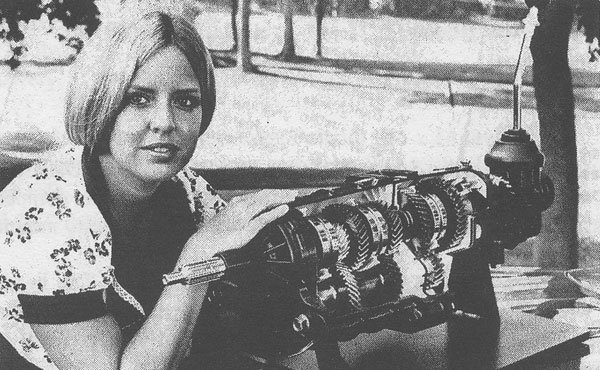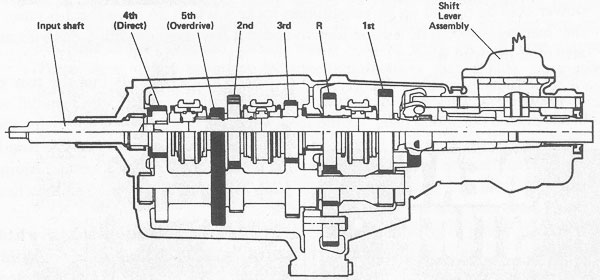
Not only is the T-50 a great transmission, you can use it to attract blonds. Can't do that with a Rover or T-5 box!
In Defense of the Borg Warner T-50 Transmission
as published in MG V-8 Newsletter, Volume VI Issue 2, August 1998
by: Jim Blackwood
Well, I guess its all in what you're looking for, over the past several issues
I've read a number of letters criticizing the stalwart T-50, and I think it
should get equal time. While it's true that some of the criticisms have a
basis of sorts, I hope to explain those and show the transmission's virtues.
It has been said that first gear is useless. This is far from correct in all
cases. To start with, there are two varieties of the transmission,
distinguishable by the number of rings cut around the input shaft as I recall,
and I have tried both in the MG. The preferred unit is the close ratio box
which comes out of a V-8 Monza (Chevy of course). This makes for a very
sporting and flexible powertrain as I will describe, but first, - ita concedo -
were you to place the wide ratio box behind the V-8 there will be trouble.
First gear becomes useless for anything short of a massive (but short)
"Hole Shot", and it's too far between the other gears. It would end up being
your "four speed with a "Granny Low". This wide ratio box is pretty common
since it was used behind all four cylinder motors and in the S-10 trucks,
whereas the performance oriented close ratio box, used in the lightweight
Monza with V-8 power (265 and up) was sold primarily to enthusiasts. You have
to wonder what they were thinking when they built this box, with its good
ratios and a somewhat unusual shift pattern, but the answer has to be that
Monzas were being used on road racing courses, and they wanted a suitable
five speed. Since first gear was used for starting only (usually on Pit Row)
the first-second shift was not critical, but the rest of the pattern had to
be perfect. Ergo, the traditional "H" for the upper gears with first gear
leading into the pattern... Putting reverse above first allowed a compact
and fairly conventional layout of the gears and a very direct arrangement
of shift rails for added strength and more reliable shifts. By the way, don't
let the compact size of the case fool you, the gears and synchros are quite
ample. (Ribbed thin-wall casting techniques were used to minimize size and
weight.)
To prevent accidental shifts into reverse from first gear, an ingeniously
simple solution in the form of a lockout tab was provided and it works exactly
as it was intended to, provided it hasn't been damaged by external forces.
Any shift to reverse or first is against a reasonably strong spring detent
which only a real ham-fisted driver could miss, and once in first a shift
directly to reverse is impossible since you must first release then re-compress
the detent. A shift from first to second is only a push away, and then you're
in the "H". Since no road course would require you to downshift to first,
fighting the detent while - in extremis - would not be a problem, and it is
easily negotiated under less stressful conditions such as in the Pits (or
at a stop sign, or red light). Of course, the "H" pattern, as used in the
upper gears is the beloved of all drivers, and cannot easily be beat for ease
of use, simplicity, etc.
As I mentioned, this is a compact yet beefy transmission, with internal parts
designed to take the abuse of an American V-8 in a lightweight car (by American
standards) and designed for racing. As a result it uses needle bearings
throughout, and lightweight, non-foaming, automatic transmission oil for a
lubricant and coolant. As mentioned the gears are large, much larger than
those seen in any of the boxes used in the MG's. The shift rails are also
heavy and rigid, as is the shifter and the gates, and the synchros are massive
by MG standards, having perhaps as much as three or four times the swept area.
Here too, construction is of a typical, durable, effective and very reliable
design identical in nearly all respects to the famous Muncie four-speed, with
a hub, ring, two synchros, three blocker rings, and two large C-shaped keeper
springs. They are very effective, and can withstand more abuse than nearly
any driver can give them without blowing an elbow. HOWEVER, it must be
remembered that you are dealing with a bit more mass than in a smaller
transmission, and it takes just a bit longer to slow it down. The smallest
bit of patience and planning in your shift points goes a very long way in
alleviating the frustration of an impatient driver with perceived "hard shifts".
The transmission does not shift hard. In fact it is a very easy shifting
transmission if allowed to do its job. It will not, however, allow you to
force it into grinding gears, and if you try it will abuse your tendons at
least as badly as you abuse its synchros.
As far as usable ratios are concerned, again, what are you looking for?
A sporting ride, or a luxo-sedan? I hear talk about axle ratios like 2.70's
and such with an overdrive, and I would he astounded if not for the realization
that these cars are not intended to ever be driven hard. I'll explain why.
With the stock 3.90 axle, the T-50's overdrive fifth gear, and 24 inch diameter
tires a 5,000 RPM redline brings me up to 150 MPH with extremely good
acceleration in all gears. Cruising at 75 MPH, the motor is ticking over at
three grand and punches through the 100 mark in nothing flat. The car comes
off the line like a rocket and the 1-2 shift comes on the other side of the
intersection right after the hole shot, just as it should be. Above first,
all ratios are well placed, and the car is tractable and docile, yet powerful.
On flat land or downhill starts (and mild uphills) starting in second is not
a problem, making in-town driving no more of a chore than with any four-speed,
using the conventional shift pattern. Use of the stock sized tires, something
better than two inches larger in diameter, would drop the cruising RPM @ 75
to less than 2800, and increase the top speed at redline (6000) to over 162MPH.
I think we can all agree that this engine with a mild buildup is capable of
supporting those numbers in this vehicle. The point is that you don't need
to go any faster than that, but it sure is nice to have the acceleration.
I don't honestly believe you'll gain very much fuel economy by dropping
the engine speed another 500 or more RPM, as it's just loafing along anyway
and with its short stroke runs very well at speed. If that's the goal,
a better solution is fuel injection.
|
Enjoying this article? Our magazine is funded through the generous support of readers like you! To contribute to our operating budget, please click here and follow the instructions. (Suggested contribution is twenty bucks per year. Feel free to give more!) |
Finally, in fitting the tranny to the MG, bellhousings are available from
Phil Baker and from Dan LaGrou and a hydraulic throw-out bearing is a stock
Chevy item. It is possible to use the stock crossmember with only minor
alterations and a GM tranny mount. A little bending of the shifter will
let it come through the floor in the right place, and after removal of the
shifter extension the shaft can be ground, polished, painted, (chromed if
you like) and a custom shifter fashioned for the top, allowing you to
further individualize your car (or you can buy a knob). BTW, the pattern
is very tight and precise when set up this way.
So why the bad rap? I think a few people have tried the wide ratio boxes,
with the (now) obvious resulting disappointment. If you get the right one
though, it's a whole new story. Best of' all, they're dirt cheap. I believe
I bought one for $100 and the other for $80, and the good one was the
cheaper one. So try adding this to your bag of tricks. You'll be glad
you did.
Editor Kurt Schley added this note: The first transmission I had in my
MG V-8 was a T-50 which I was unhappy with because of the unusable first
gear and the unusual reverse gear shift position. I unconsciously shifted
into reverse, thinking I was in first, several times and almost ended
up as a hood ornament on the car behind me. Two years ago I switched to
a T-5. After reading Jim's excellent article, I now realize that I had
the wide ratio 6-cylinder box and that the reverse detent was not working
on mine. To the T-50 transmission, I offer my apologies for all the bad
things I said about you! Jim is also correct in stating that the T-50 is
inexpensive. The last three I have seen at swap meets were all less than $150.

SPECIFICATIONS AND DESIGN FEATURES OF THE
BORG-WARNER T50 FIVE-SPEED MANUAL TRANSMISSION
The T50 is a five-speed manual transmission of a floor-shift type, fully synchronized
in all forward speeds. It features a single rail shifter with shifting mechanisms
totally enclosed.
It is end loaded, allowing use of an oval case for greater strength. It is designed
to be interchangeable (with minimal adjustments) with current production manual
transmissions of similar capacity.
Gear ratios (can be modified to customer requirements):
| Vehicle Application: | 1st | 2nd | 3rd | 4th | 5th | REV |
| Overdrive top (smaller engines) | 3.41 | 2.08 | 1.40 | 1.00 | 0.80 | 3.36 |
| Overdrive top (larger engines) | 3.10 | 1.89 | 1.27 | 1.00 | 0.84 | 3.06 |
| Direct top | 3.49 | 2.48 | 1.83 | 1.37 | 1.00 | 3.49 |
| Efficiency: | |
| 1st gear | 95.2% |
| 2nd gear | 96.5% |
| 3rd gear | 96.3% |
| 4th gear | 99.0% |
| 5th gear | 96.5% |
Case and extension housing: Die-cast aluminum.
Weight: 65 pounds.
Gears: Helical throughout, including reverse; constant mesh reverse.
Operating temperature: -30°F to 250°F with current seals and the specified
lubricant; to 275°F with higher temperature seal material.
Synchronizer capacity: Consistent with a 205 pounds/feet passenger car
application. Larger 1-2 synchronizer is available.
Oil retention: Dynamic oil seals are provided. Use of room temperature
vulcanizing (RTV) static seal material eliminates oil leakage and provides
metal-to-metal fit of mating parts.
Shift travel: Adaptable to customer requirements.
Other features: Live countershaft, blocker-type synchronizers, needle
bearing support throughout and needle thrust bearings on the main shaft.
Notice:
With digitization of this article in 2008, Jim Blackwood suggested the following additional comment:
"I feel the torque limit of 205 ft/lbs should be strictly adhered to!"
Disclaimer: This page was researched and written by Jim Blackwood. Views expressed are those of the author, and are provided without warrantee or guarantee. Apply at your own risk.


